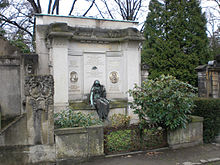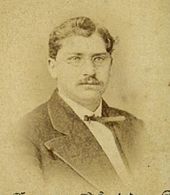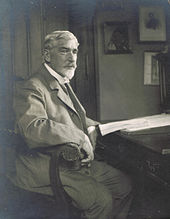Felix Martin Oberländer
Felix Martin Oberländer (born January 8, 1851 in Dresden ; † October 2, 1915 there , also Felix Martin Oberlaender ) was a German physician. He is considered the founder of modern urology , especially in the fields of infectious diseases and endoscopy .
Life

Oberländer was born in Dresden as the son of a high government employee. His father Martin Gotthard Oberländer was Minister of the Interior in the “March Cabinet” under Karl Alexander Hermann Braun for almost a year from 1848–1849 and later continued to work in the Ministry of the Interior. He completed his school education mainly at the Dresden Kreuzschule , where he graduated from high school in 1870.
Oberländer began studying human medicine in the summer semester of 1870 at the University of Leipzig . There he belonged to the Leipzig fraternity Dresdensia . After completing the physics course, he continued his studies at the University of Greifswald . There he belonged to the Greifswald fraternity Rugia . In 1874 he was after passing the first medical state examination at the University of Greifswald with the thesis A case of cysticercus cellulosce in the mesentery of man Dr. med. PhD. He continued his studies in the years 1874–1876 possibly in Halle, Munich, Vienna and Paris. After passing the second state examination, he was from 1875 to 1878 with Franz von Winckel and Julius Otto Martini (1829-1909) - at times together with Maximilian Nitze - assistant at the city hospital in Dresden-Friedrichstadt. He then settled down as a urologist and opened a private clinic in Dresden. Oberländer was considered a master of bladder and ureter reflections. Later he was appointed professor at the Surgical Medical Academy in Dresden and was an honorary doctor of several universities as well as co-editor of the Centralblatt for Physiology and Pathology of Diseases of the Urinary and Sexual Apparatus and the Journal for Urology . Oberländer played a major role in the emancipation of urology from dermatology . In 1906 he led the founding of the German Society for Urology as senior president . In addition to his job, he was also known as a botanist and art collector.
Oberländer was buried in the family grave at the Johannisfriedhof in Dresden-Tolkewitz , for which the sculptor Richard König had created a grave figure.
Felix Martin Oberländer Prize
The German Society for Urology awards the Felix Martin Oberländer Prize annually . The Oberländer Prize is one of the most important awards in the field of urology in Germany.
Publications (selection)
- For knowledge of the nervous disorders of the man's urinary system. Leipzig 1886.
- On the practical importance of the gonococcus. Fischer, Berlin 1888.
- International Central Journal for the Physiology and Pathology of the Urinary and Sexual Organs. Issues 4–6, 15–17: by FM Oberlaender ;: L. Voss, Hamburg / Leipzig 1890–1906.
- Urethroscopy textbook. Thieme, Leipzig 1893.
- as co-author: Clinical Handbook of the Urinary and Sexual Organs. Vogel, Leipzig 1894.
- with Arthur Kollmann : The chronic gonorrhea of the male urethra and its complications. Leipzig 1901/1905. (2nd edition 1910).
literature
- Albrecht Scholz: Felix Martin Oberländer's contributions to urology. In: The Urologist. [B], Vol. 37, Vol. 1997, pp. 251-255.
- Albrecht Scholz: Dresden contributions to endoscopy: Maximilian Nitze and Felix Martin Oberländer. In: M. Skopec, R. Nederost, M. Zykan (Eds.): Milestones in endoscopy. Literas Universitätsverlag, Vienna 2000, pp. 75–88.
- Albrecht Scholz, Caris-Petra Heidel: Dresden traditions in the field of endoscopy in the second half of the 19th century. In: Würzburg medical history reports. 19, 2000, pp. 221-237.
- Albrecht Scholz, Jörg Schubert: Dresden on the way to an independent urology in the first half of the 20th century. In: Dirk Schultheiss, Friedrich Moll: The history of urology in Dresden. Springer Medizin Verlag, Heidelberg 2009, pp. 67–75. (Digitized version)
- Susanne Zimmermann: Oberländer, Felix Martin. In: New German Biography (NDB). Volume 19, Duncker & Humblot, Berlin 1999, ISBN 3-428-00200-8 , p. 391 ( digitized version ).
- Werner Reusch: Cronik of the Leipzig fraternity Dresdensia. Ratingen 2009.
- Werner Reusch: Regular role of the B! Dresdensia Leipzig from 1853–1899. Giessen 2006.
- Hugo Lohnstein: Felix Martin Oberländer †. In: Journal of Urology. Volume IX, Issue 11, 1915, pp. 400-405. (with a portrait of FM Oberländer); see. also the obituary of Fritz Boehme in the same issue, pp. 406–408.
Web links
Individual evidence
-
↑ The following article contains detailed genealogical information about the Oberländer family: Alfred Lindner: Two ministers from a Langenbernsdorfer family (Oberländer). In: Crimmitschauer Anzeiger and Tageblatt. Supplement to the Crimmitschau Heimat papers. Born in 1929. Detailed genealogical documents about the family are publicly accessible in the following archive: Werzeit Genealogie Bibliothek e. V. Katharinenstr. 18, Werdau.
One of Felix Oberländer's brothers is the writer Richard Oberländer . - ↑ 1864–1870 attendance at the Kreuzschule, previously attending a Freemason facility (cf. Ecce der Crucianer. Born 1915, p. 11 f.).
- ↑ Master role of the B! Dresdensia Leipzig from 1853–1899 , Giessen, 2006.
- ^ Rugia album and regular role of the Greifswald fraternity Rugia 1856-1936. Greifswald 2006.
- ↑ The stations in Halle, Munich and Vienna are mentioned in contemporary biographical sketches, but have not been found in recent times. See A. Scholz: Felix Martin Oberländers contributions to urology. In: The Urologist. [B], Jg. 37/1997, pp. 251-255 with further references.
- ^ A b Isidor Fischer (Ed.): Biographical Lexicon of the Outstanding Doctors of the Last Fifty Years , Volume 2, Urban & Schwarzenberg, Munich / Berlin 1962, p. 1135; Dietrich von Engelhardt: Biographical encyclopedia of German-speaking physicians. Saur, Munich 2002, p. 444; J. Pagel: Biographical lexicon of outstanding doctors of the nineteenth century. Urban & Schwarzenberg, Berlin / Vienna 1901, column 1217 f; Hugo Lohnstein: Felix Martin Oberländer †. In: Journal of Urology. Volume IX, Issue 11, 1915, pp. 400-405; Ecce the Crucian. Born 1915, p. 11 f.
- ↑ a b c Volker Klimpel: Dresden doctors. Historical-biographical lexicon. Hellerau-Verlag, Dresden 1998, sv
- ^ Felix Martin Oberländer: Obituary for Maximilian Nitze . In: Centralblatt for the diseases of the urinary and sexual organs. XVII, 1906, p. 121.
- ^ Gesina Hansel: 120 years of skin clinic Dresden-Friedrichstadt . In: The dermatologist. Organ of the German Dermatological Society. Vol. 46, 1995, pp. 278-282.
- ^ I. Fischer (ed.): Biographical lexicon of the outstanding doctors of the last fifty years. Volume 2, Urban & Schwarzenberg, Munich / Berlin 1962, p. 1135.
- ↑ Mention is made of the medical devices developed or improved by Oberländer, e.g. Partly with illustrations, In: Medicinisches Waarenhaus AG. (Ed.): Main catalog No. 33 on surgical instruments, medical equipment, special instruments. Berlin approx. 1910 (Reprint: Th. Schäfer, Hannover 1987, Libri Rari series), pp. 234 f., 238, 282.
- ↑ Oberlander's role in the development of urological endoscopy is extensively acknowledged In: Albrecht Scholz, Caris-Petra Heidel: Dresden traditions in the field of endoscopy in the second half of the 19th century. In: Würzburg medical history reports. 19, 2000, pp. 221-237. The role of the various protagonists in this development, including Oberländer, is discussed in detail in: Ingrid Garke, geb. Maczuck: The development of urological endoscopy in the field of tension between medicine and technology. Dissertation . Aachen 1980. passim on FMO cf. especially pp. 77 f., 83 f., 148.
- ↑ At the meeting Oberländer said: “We have gradually and surely managed to stand on our own feet and firmly, independently of any other discipline, and this new position is to be documented to the outside world today through our foundation.” (Cf. C Posner: Felix Martin Oberländer †. In: Dermatologische Wochenschrift. Volume 61, No. 46, November 13, 1915, p. 1063. Cf. also J. Konert, F. Moll: 100 years "German Society for Urology". In: Der Urologe . 45/2006, p. 1101. Konert's essay is flawed: the portraits of Oberländer and Otto Zuckerkandel are reversed and the year of death Oberländer is incorrectly stated).
- ↑ Cf. Ecce the Crucians. Born 1915, p. 11 f., Where it says among other things: “[He] devoted himself with particular zeal and great success to the cultivation of plants, namely the cultivation of orchids , through which he acquired a reputation that reached far beyond his fatherland. He organized exhibitions in his greenhouses for charitable purposes and received gold and silver medals for sending exhibitions [...] "
- ↑ It concerns the common grave of the Dresden families Oberländer and Schaffrath, Johannisfriedhof in Dresden-Tolkewitz, field 4, Bogen, 045.
- ^ Fritz Böhme: Obituary for Felix Martin Oberländer. In: Journal of Urology. Volume IX, Issue 11, 1915, pp. 406-408.
- ^ Conni Licht: Appearance. The most beautiful grave figures from Dresden. [Dresden] 2009, unpaginated, cf. P. [83] and section “Artists and Service Providers” at the end of the book.
- ↑ Awards and prizes ( Memento from August 1, 2012 in the web archive archive.today ) dgu-kongress.de
- ^ Prize winners: 1997 H. Madersbacher; 1998 K. Naber; 1999 J. Altwein; 2000 W. Weidner; 2001 RH Ringert; 2002 M. Stöhrer; 2003 Albrecht Hesse, Bonn; 2004 Helmut Heidler, Linz; 2005 Rolf Harzmann, Augsburg; 2006 Paolo Fornara, Halle; 2007 Rolf Beetz, Mainz; 2008 K. Dreikorn; 2009 Herman Josef Berberich, Hofheim; 2010 Jens Rassweiler, Heilbronn; 2011 Axel Semjonow, Münster. Award winners. ( Memento from February 10, 2013 in the web archive archive.today ) as well as honors and prizes from the German Society for Urology. In: The Urologist. [A], 43/2004, p. 333 f; Dirk Schultheiss, Friedrich Moll: The history of urology in Dresden. Springer Medizin Verlag, Heidelberg 2009, pp. 141–154.
| personal data | |
|---|---|
| SURNAME | Oberländer, Felix Martin |
| BRIEF DESCRIPTION | German urologist |
| DATE OF BIRTH | January 8, 1851 |
| PLACE OF BIRTH | Dresden |
| DATE OF DEATH | October 2, 1915 |
| Place of death | Dresden |

